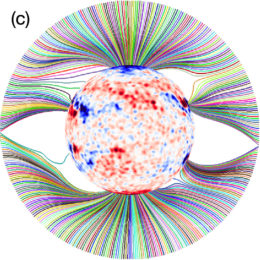General models of the Sun’s atmosphere have a fundamental problem: the magnetic flux they predict here at Earth is much lower than what we actually observe. Has a new study found the missing flux?
When Models and Observations Don’t Match
The Sun offers us a unique opportunity to study stellar magnetic fields up close, testing the match-up between our models and observations — but, unfortunately, the outcome isn’t always ideal.

Magnetic field lines drawn from the solar surface to two times the Sun’s radius. The Sun’s magnetic field permeates our solar system as an interplanetary magnetic field. [Adapted from Riley et al. 2019]
The trouble comes when we take a closer look at the predicted strength of the modeled interplanetary magnetic field — the natural extension of the solar magnetic field into the solar system. It’s there that our global solar models have a problem: they often underpredict the strength of the interplanetary magnetic field at a distance of 1 AU (i.e., at Earth, where we can easily measure it) by a factor of two or more.
So where’s the missing magnetic flux?

Line-of-sight component of the solar magnetic field, mapped out for models without (top row) and with (bottom row) extra flux added at the poles, as seen from two different vantage points: the view from Earth in the Sun’s equatorial plane (left column), and the view from a point 30° above the equatorial plane (right column). From Earth the difference is not visible; from 30° above, it will be. [Adapted from Riley et al. 2019]
Adding to the Poles
Led by Pete Riley, a team of scientists at Predictive Science Inc. in San Diego have proposed a solution: what if this “missing” flux takes the form of concentrated bundles of magnetic flux at the solar poles that we just can’t see from our angle?
Earth’s position near the plane of the Sun’s equator makes it difficult for us to observe much of what’s happening at its poles. It’s entirely possible that there’s extra magnetic flux at the poles of the Sun — where we can’t resolve it with ground-based observatories or Earth-based spacecraft — that our models are missing. By adding this flux into our models, maybe we’ll be able to reproduce the interplanetary magnetic field measured at Earth.
A Better View Ahead
To test this theory, Riley and collaborators explore a series of global models of the Sun, reconstructing the coronal magnetic field and measuring the resulting magnetic flux at 1 AU. In their models, the authors add extra bundles of open magnetic field lines at the poles of the Sun, and they then test whether this addition creates any other changes that would conflict with current solar observations.
The authors find that their added flux significantly reduces the problem of the underpredicted interplanetary magnetic field — their values are much closer to the measured values. What’s more, the added flux also doesn’t produce any new observational discrepancies; the authors’ models still produce features in the corona consistent with what we see (and in some cases, even provide a better reproduction of observations).So how can we tell if this is a realistic solution? The upcoming joint ESA/NASA Solar Orbiter mission, launching in February 2020, is just what we need: this spacecraft will eventually orbit the Sun at an inclination of 25° and above, allowing us a more definitive look at the Sun’s poles.
Citation
“Can an Unobserved Concentration of Magnetic Flux Above the Poles of the Sun Resolve the Open Flux Problem?,” Pete Riley et al 2019 ApJ 884 18. doi:10.3847/1538-4357/ab3a98

